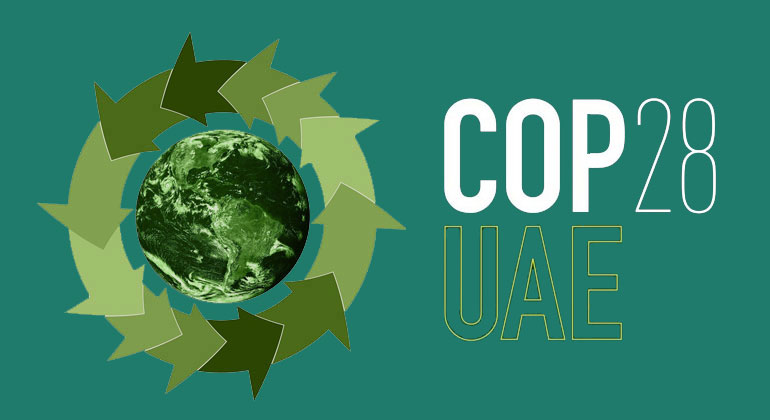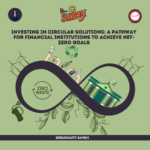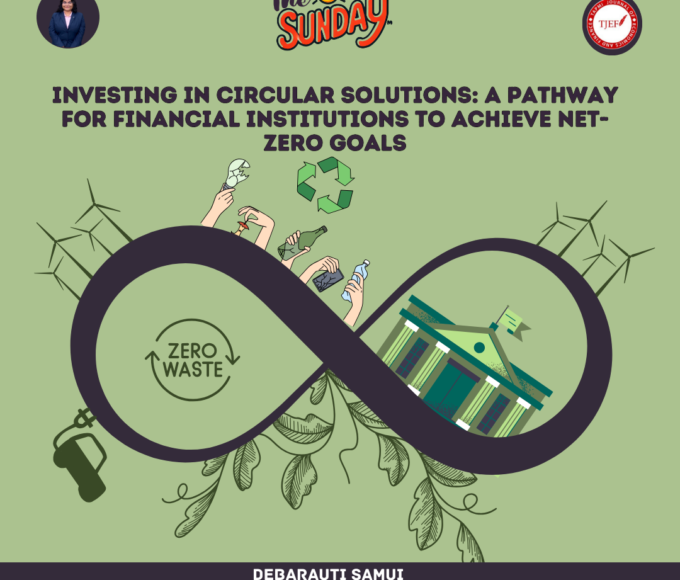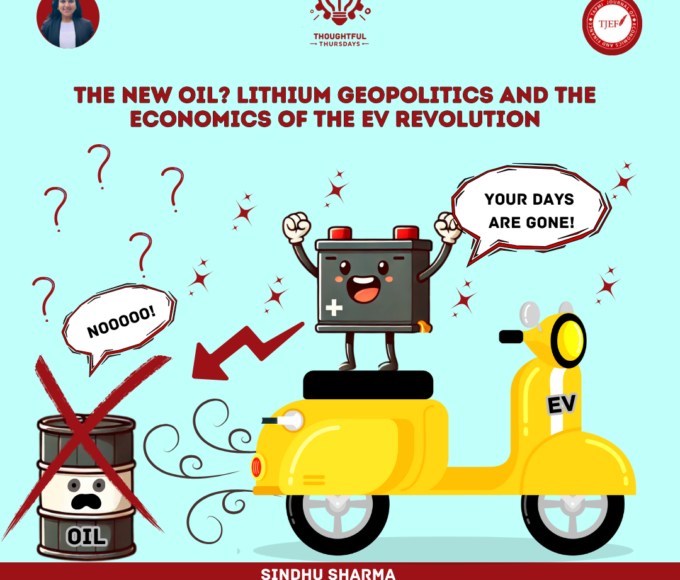Editor – Sai Janani
The COP28 convened in Dubai, UAE, from 30 Nov to 13 Dec 2023. More than 85,000 participants, including 150 Heads of State and Government, representing countries, citizens, businesses, youth, and international organizations attended the Conference.
The Conference of Parties, which meets every year since 1995, addresses the world’s efforts on climate change under the Paris Agreement. Reducing greenhouse gas emissions, strengthening active responses to a changing climate, getting financial and technological support to vulnerable nations are the prime objectives of the COP.
COP 28 urged all nations to accelerate moving away from fossil fuels to renewable energy such as wind and solar power. It also assessed the effectiveness of measures taken by countries and stakeholders, in achieving the ultimate objectives of the Convention. The conference concluded with an agreement that signals the “beginning of the end” of the fossil fuel era, a just and equitable transition, marked by deep emissions cuts and scaled-up finance. The aim is to keep the global temperature rise limit to 1.5°C within reach.
The context of climate change:
Deforestation and pollution in the environment we live in, continue to rise, pushing up the per capita greenhouse gas emissions (GHG). The result of inadequate measures to combat climate risk, per United Nations Environment Programme, will push world temperatures up by 2.9°C above pre-industrial levels.
To address these issues, the United Nations Framework Convention on Climate Change (UNFCCC) was established in 1992 during the Earth Summit in Rio de Janeiro, Brazil. The primary objective of the UNFCCC is to address global warming and its impacts on the planet. The COP meetings, starting from COP1 in Berlin in 1995, play a pivotal role in shaping international climate policy and agreements. Each COP builds on the outcomes of the previous meetings, reflecting the evolving global understanding of climate change and the collaborative efforts needed to address this pressing issue.
Key milestones:
- COP3 (1997 – Kyoto): The Kyoto Protocol was adopted, setting emission reduction targets for developed countries.
- COP15 (2009 – Copenhagen): The meeting aimed to secure a comprehensive climate agreement but resulted in the Copenhagen Accord, a political agreement that outlined voluntary emission reduction pledges.
- COP21 (2015 – Paris): The Paris Agreement was adopted, a landmark accord where nearly 200 countries committed to limiting global temperature rise well below 2 °C above pre-industrial levels.
- COP26 (2021 – Glasgow): Governments agreed to focus on limiting temperature rise to 1.5 °C rather than the less stringent 2°C pathway goal agreed on in Paris in 2015.

Measures agreed at COP28:
- World Bank will mobilize US$ 420 million during COP28 to seed a Loss and Damage Fund (LDF) to help developing nations deal with climate change.
- 118 countries pledged to triple global renewable energy capacity by 2030 from around 3400 GW today to over 11000 GW.
- Fifty companies representing over 40 per cent of global oil production committed themselves to zero carbon emissions by 2050.
- 60 countries committed to reducing global cooling emissions – that account for nearly 7 per cent of global emissions – by 68 per cent by 2050.
- COP28 also saw 22 countries sign a declaration to triple nuclear energy capacity.
- Developing countries to take the lead to eliminate their carbon footprint before 2050.
Global South Cities’ Challenges:
While communities worldwide continue to grapple with climate change, the global south faces a unique set of challenges. Cities in the global south including India are more vulnerable than their western counterparts due to inadequate empowerment of city leaders, significant employment in the informal sector, and susceptibility to climate-induced disasters. The drive to attract investments has often widened the socio-economic gap, with approximately 40% of the urban population, particularly in India, residing in slums. Addressing these challenges requires a radical shift in city governance processes.
Tikender Singh Panwar, former Deputy Mayor of Shimla, suggests creating a climate atlas for cities in the Global South, mapping and identifying hotspots to aid in effective climate action planning. This, however, requires major support from existing financial structures.
Also, during the preparation of Nationally Determined Contributions (NDCs) and National Adaptation Plans, cities are often excluded from the process of climate action plans. Despite challenges, some cities like Chennai have decided to meet their zero emission targets by 2050, even before the Indian national government’s stipulated time period of 2070. Reclaiming space for city leaders and civil society groups in climate action plans, especially during the preparation of Nationally Determined Contributions (NDCs) and National Adaptation Plans, is key to ensuring fair participation and compensation for loss and damage.
India-specific initiatives:
Among the BRICS economies, the per capita GHG of India is the least at 2.8 tons in 2021 as against Brazil – 10 tons, Russia – 16.6 tons, China – 9.6 tons, and South Africa – 9.3 tons. The US is 17.6 tons.
- National Mission for Sustaining the Himalayan Ecosystem (NMSHE) was launched pursuant to the National Action Plan on Climate Change (NAPCC). This was initiated to understand the impact of climate change on the Himalayan ecosystem.
- At the India Pavilion, “Localising Climate Action”, a publication on India’s climate action journey from COP-21 in Paris to COP-28 in the UAE was released. It renews India’s commitment towards UN climate change actions.
- In the Budget for 2023-24, the Indian government has allocated funds for the Mangrove Initiative for Shoreline Habitats and Tangible Incomes or, MISHTI. Under this scheme, mangrove plantations along the coastline and on salt pans are being taken up.
- India has reduced the emission intensity vis-à-vis its GDP by 33% between 2005 and 2019, thus achieving the target for 2030, 11 years ahead of the scheduled time.
- India has reported 40% of energy installed capacity through non-fossil fuel sources, nine years ahead of the target for 2030. Between 2017 and 2023, India has added around 100 GW of installed electric capacity, of which around 80% is attributed to non-fossil fuel-based resources.
- India participates actively in international efforts like the International Solar Alliance (ISA), Coalition for Disaster Resilient Infrastructure (CDRI), the creation of LeadIT, Infrastructure for Resilient Island States (IRIS) and the Big Cat Alliance, the Global Biofuel Alliance etc.
Challenges for India:
For a greener earth, agriculture, sustainability, and climate change are closely intertwined. India, being a major player in the global agricultural landscape, faces the dual challenge of providing food for its growing population while mitigating the impacts of climate change on its farming communities.
The way forward involves a comprehensive strategy that integrates climate-resilient farming techniques, efficient water management, deployment and judicious use of crop protection products, and the adoption of advanced and safer technologies.
India could prioritize agroecological approaches, such as progressive farming, with the latest technology to enhance productivity while minimizing environmental impact. Investing in climate-smart crop varieties, implementing efficient irrigation systems, and promoting soil health are essential to a sustainable agriculture agenda. Additionally, enhancing the resilience of smallholding farmers through training programs and access to climate information at the right time is again crucial. Collaboration between the government, agricultural experts, and the private sector is key to developing and disseminating sustainable practices.
As a developing economy, much of India’s infrastructure and manufacturing capacities are still under construction across the country. The primary aim of this activity is to provide employment and reduce the disparities in the living standards across social strata. A large part of economic growth and lifting people from poverty, relies heavily on energy consumption. So, the challenge before India is to balance the economic growth with commitment to COP on green objectives and transition to renewable energy.
Conclusion:
The global stocktake is considered the central outcome of COP28 as it contains every element that was under negotiation and can now be used by countries to develop stronger climate action plans due by 2025. The global stocktake is like taking inventory. It means looking at everything related to where the world stands on climate action and support, identifying the gaps, and working together to chart a better course forward to accelerate climate action. The stocktake takes place every five years, with the first-ever stocktake set to conclude at COP28.It is intended to inform the next round of climate action plans under the Paris Agreement (nationally determined contributions, or ‘NDCs’) to be put forward by 2025.
It was resolved that global greenhouse gas emissions need to be cut by 43% by 2030, compared to 2019 levels, to limit global warming to 1.5°C. The countries are off track when it comes to meeting their Paris Agreement goals.
Negotiators from nearly 200 parties attending the event came together with a commitment to enhance climate action before the end of the decade – with the aim to keep the global temperature limit of 1.5°C within reach.
COP28 notably closed with an agreement that signals the “beginning of the end” of the fossil fuel era by laying the ground for a swift, just, and equitable transition, underpinned by deep emissions cuts and scaled-up finance. UN Climate Change Executive Secretary Simon Stiell said in his closing speech. “Now all governments and businesses need to turn these pledges into real-economy outcomes, without delay.”
References:
https://www.mckinsey.com/featured-insights/mckinsey-explainers/what-is-cop















Leave a comment